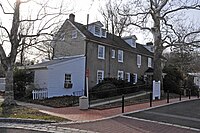Pennsylvania School of Horticulture for Women
 |
|
| Established | 1910; In 1958 merged with Temple University Ambler |
|---|---|
| Address |
580 Meetinghouse Road, Ambler, PA 19002, Ambler, Pennsylvania, USA 40°09′52″N 75°11′33″W / 40.1645°N 75.1925°WCoordinates: 40°09′52″N 75°11′33″W / 40.1645°N 75.1925°W |
| Campus | Suburban |
The Pennsylvania School of Horticulture for Women was one of the first horticultural schools to be established by and for women in the United States, opening on February 10, 1911. As the second institution to provide women with a practical education in horticulture and landscape architecture, it made possible their entry into a professional field. Although some men were employed in faculty positions, the school's leadership was intentionally female. As of 1919, the board of trustees consisted of twenty-five prominent women citizens. All but the last director of the school were women.
The school played a "unique role" in women's history and garden history. Members of the school were instrumental in the establishment of the Garden Club of America (1913), the Woman's National Agricultural and Horticultural Association (1914), the Woman's Land Army of America (1917), and the publication of the Farmer's Digest. It served as a national and international model for other institutions, such as the Keisien School in Japan.
In 1958, the school merged with Temple University Ambler and became co-educational.
The school was founded by Jane Bowne Haines (1869-1937). Haines was born into a well-off Philadelphia Quaker family with an established tradition of horticultural practice, which enabled her to educate herself about horticulture. She studied formally at Bryn Mawr College and the New York State Library School in Albany, New York. Working in the fruit and shade-tree nursery on her family's estate in Cheltenham, Pennsylvania, she became determined to found a school of practical horticulture for women in the Philadelphia area. It was a pioneering effort, preceded in the United States only by the Lowthorpe School in Groton, Massachusetts.
While travelling in Europe, Haines visited women's schools in England and Germany. She was particularly inspired by two horticultural colleges in England, the Studley School near Reading, and the Swanley School near London.
...
Wikipedia
